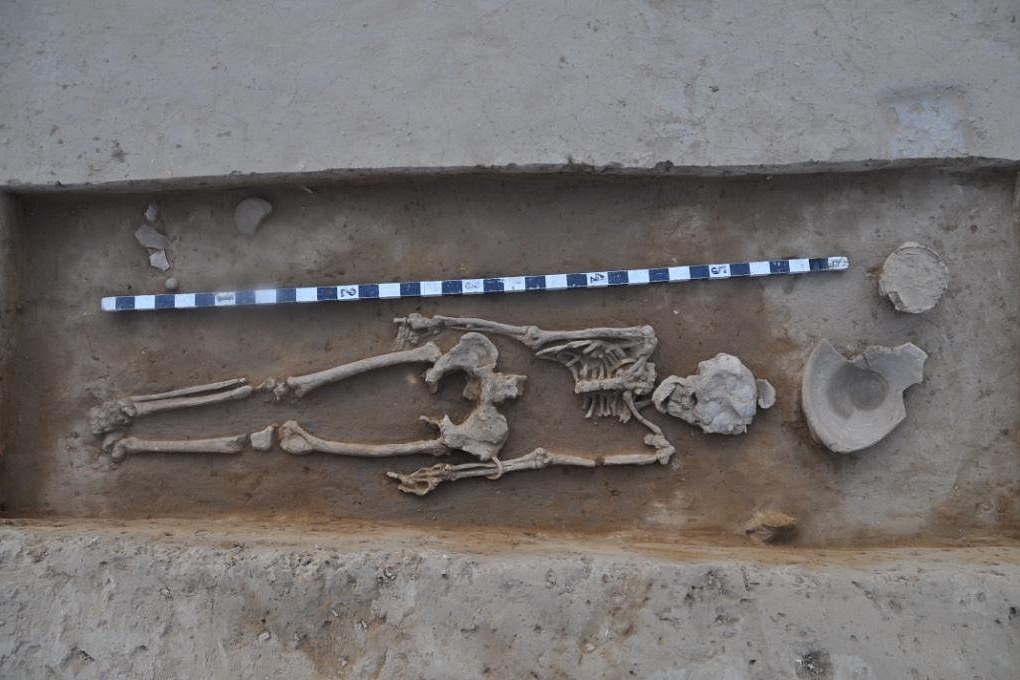Insta
Rakhigarhi DNA: What Does It Really Reveal As Of Now?

A human skeleton found at the Rakhigarhi site. (pic via Twitter)
A recent report in Economic Times announced thus: 'Harappan site of Rakhigarhi: DNA study finds no Central Asian trace, junks Aryan invasion theory'. Naturally it has invited great interest and with it controversy. According to archaeologist Vasant Shinde of the Deccan College, Pune and Neeraj Rai the head of the ancient DNA laboratory at Lucknow’s Birbal Sahni Institute of Palaeosciences (BSIP), the DNA extracted from Rakhigarhi sites, reveal no 'Central Asian/Steppe element in the genetic make-up' of the Harappans.
At the outset the study seems to suggest that the Harappans were indigenous and that they were either replaced by or had admixture from Steppe/Central Asian population - that is the standard Aryan invasion or migration model. But what is interesting is the observation by Rai that the excavations at the Rig Vedic phase show 'greater continuity rather than to a new Aryan race descending and bringing superior knowledge systems to the region.'
Here one should remember that the DNA sample itself is meager - two samples from 148 skeletal remains. So the absence of the so-called steppe component (by which if they mean R1a - which a section of geneticists like Dr. Gyaneshwar Chaube think may be more of Indian origin) in the two samples actually prove nothing conclusively though the presence of R1a would have definitely settled the debate against the Aryan invasion/migration model. One should also take into account the fact pointed out by Stanford University School of Medicine's Department of Genetics scientist Peter Underhill in his communication to Swarajya earlier that the ‘the overall distribution of various R1a lineages is a minority fraction’. So the absence of R1a in such a small sample proves nothing conclusively.
However the enigmatic statement by Rai about continuity through the 'Rig Vedic phase' actually raises the question that even if R1a is tied to be of Steppe origin, whether it can be definitely tied up with the Vedic culture. Author Sanjeev Sanyal too has questioned linking of R1a to 'Central Asia' in his recent tweet.
Dr. Peter Underhill's 2015 paper has already found 'the geographic distribution of R1a-M780' might reflect 'early urbanization within the Indus Valley'.
The continuity of culture from Harappan to post-Harappan period, which these authors consider as Vedic, clearly suggests that there were no major population intervention from outside. Already archaeologist Shinde, talking to the Open magazine, has pointed out that he is comfortable with the term 'migration' as people were moving in and out - it was rather a bi-directional movement rather than an uni-directional migration.
So given all these aspects from the way things unfold, it seems the paper by Shinde and Rai may look at the genetic evidence in the holistic context of archaeological context, civilisation, culture and language. Meanwhile, we will be seeing hyperbole, twists left and right, according to what one wants to see, converting the journalist glimpses of the yet to come genetic study into a veritable ideological Rorschach test.
Support Swarajya's 50 Ground Reports Project & Sponsor A Story
Every general election Swarajya does a 50 ground reports project.
Aimed only at serious readers and those who appreciate the nuances of political undercurrents, the project provides a sense of India's electoral landscape. As you know, these reports are produced after considerable investment of travel, time and effort on the ground.
This time too we've kicked off the project in style and have covered over 30 constituencies already. If you're someone who appreciates such work and have enjoyed our coverage please consider sponsoring a ground report for just Rs 2999 to Rs 19,999 - it goes a long way in helping us produce more quality reportage.
You can also back this project by becoming a subscriber for as little as Rs 999 - so do click on this links and choose a plan that suits you and back us.
Click below to contribute.
Latest